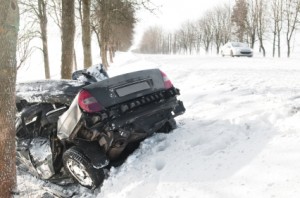Winterizing Your Insurance: Getting Ready for Winter Driving
We make sure that our vehicles are ready for winter driving, but don’t forget about your car insurance as well.
It’s November, and while we haven’t yet reached the winter solstice, a good deal of us are already seeing winter driving conditions. For those of us that deal with snow and ice as a normal part of our winters, we are used to the annual winter driving checklist. Which includes: putting on our snow tires, making sure that the snow brushes and ice scrapers are in the car and that the emergency weather kits are restocked and back in the trunk for the season.
But, is your insurance ready for the winter driving as well? Even the most prepared driver can get into a car accident in the winter. It doesn’t even have to be on the snow and ice. Warmer areas see an increase in rain during the winter months which can still make the roads more dangerous than what you are used to.
Do You Have Enough Coverage for the Winter Driving Season?
Unless you don’t drive during the winter at all, we all have an increased chance of getting into a car accident this time of year. Even those that are used to winter driving conditions still fall prey to Mother Nature’s winter temper tantrums.
If you were to get into a car accident, do you have enough insurance coverage? The minimum liability insurance limits that the states require for you to be able to drive are extremely low. If you were to cause an accident and only had state minimum insurance, there is a very high chance that you won’t have enough coverage. Any damages that you cause that are above and beyond what your insurance limits are at, will come out of your pocket.
Where’s Your Deductible At?
Going into the winter driving season is a good time to take a look at your insurance deductible. Is your comprehensive and collision deductible set at an amount that you can afford to pay if you were to get into a car accident?
For example, say you hit winter driving conditions and got into an accident. The accident resulted in $2000 worth of damages to your car. If you have a $1000 deductible, you are responsible for paying $1000 of the $2000 worth of damages. Do you have the money set aside to pay this?
If you were to get into an accident where the damages were less than $1000, you would be responsible for paying the total amount of the damages. If you couldn’t afford this and the damages made it so that your vehicle could not be driven; you are going to be without a vehicle.
With the increased chance of an accident during winter driving, make sure your insurance deductible is at a level that you can easily pay.
Storing Your Car for the Winter Driving Season?
For many, the car that they drive around in during the summer is not used for winter driving. This is especially true for classic and antique car owners and also snowbirds. But, it also applies to those that don’t drive in the winter because it is too dangerous.
No matter the reason, if you have a vehicle that sits in storage during the winter months you may actually have too much insurance on your car. State law only requires that you carry the mandatory liability insurance on a vehicle that is being driven. So if you aren’t driving it, you don’t have to carry liability insurance on it. You also don’t need medical coverage, towing or rental car coverage for a vehicle that is sitting the season out.
Just keep in mind though, that if you fail to secure your vehicle and it rolls out and causes damages, you are still liable for the damages. Your agent will be able to provide you with advice as to the best insurance for you personally during the winter driving season.
Trackback from your site.

